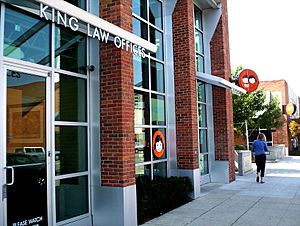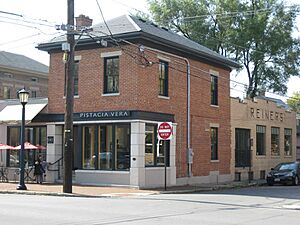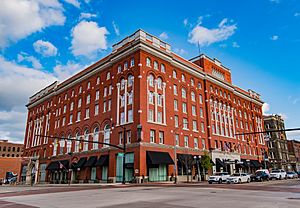German Village facts for kids
|
German Village
|
|

S. 3rd Street in German Village
|
|
| Location | Columbus, Ohio |
|---|---|
| Built | 1820 |
| Architectural style | Italianate |
| NRHP reference No. | #74001490 , #80002998 |
Quick facts for kids Significant dates |
|
| Added to NRHP | December 30, 1974 |
| Boundary increase | November 28, 1980 |
German Village is a special historic neighborhood in Columbus, Ohio. It's located just south of the city's downtown area. Many German immigrants settled here in the early to mid-1800s. At one point, they made up about a third of all the people in Columbus!
In 1960, German Village became a city historic district. Later, in 1974, it was added to the National Register of Historic Places. This list recognizes important historical places across the country. German Village is known as one of the largest historic areas saved by private money. In 2007, the government even named it a Preserve America Community. Today, it is famous worldwide for its amazing restoration.
Contents
A Look Back: German Village History
How German Village Began
In 1796, the U.S. Congress set aside land for people who helped the American side during the American Revolution. A veteran named John McGowan claimed a large piece of this land. This land later became most of German Village.
As German immigrants arrived in the early 1800s, McGowan sold parts of his land to them. By 1814, a small community had formed. It was first called "Das Alte Südende," which means "the Old South End." German immigrants also helped build the first statehouse in Ohio.
German Immigrants Arrive
By 1830, many more German immigrants had moved to Columbus. They started newspapers, like Der Westbote, which was very important in 1843. Many German Americans fought in the American Civil War. This earned them a lot of respect from other citizens.
By 1865, one out of every three people in Columbus was German. The community was thriving! They built many local businesses, schools, and churches. One famous church is St. Mary's Catholic Church, built in 1865. It has a tall steeple that is 197 feet high. A German-American named George J. Karb even became the mayor of Columbus twice!
In the early 1900s, other people from Eastern Europe also moved to the south end. This led to other neighborhoods forming, like the Hungarian Village. The schools built by German immigrants were so good that even English-speaking families chose to send their children there.
World War I Changes Things

The German Village area faced tough times in the early 1900s. This was partly because of strong anti-German feelings during World War I. During this time, teaching German in public schools was stopped. German street names were changed, like Germania Street becoming Stewart Avenue. Schiller Park was even temporarily renamed Washington Park.
Despite these challenges, the German-American community in Columbus produced a war hero. Captain Eddie Rickenbacker was one of America's best pilots in World War I. The Rickenbacker International Airport in Columbus is named after him.
A Neighborhood in Decline
The area continued to decline after World War I. When breweries closed during Prohibition, it also hurt the community. After the war, the south end was set aside for factories. This made the area feel less like a neighborhood. By the 1950s, the area was in poor condition. The city even planned to tear down a third of the neighborhood.
Bringing German Village Back to Life
Frank Fetch's Vision
The German Village was almost completely destroyed. But a man named Frank Fetch had a different idea. He bought a house on S. Wall Street, determined to fix up the neighborhood. Fetch then started the German Village Society.
In June 1960, the society held its first "Haus und Garten Tour." This event showed off eight restored homes and two gardens. Many visitors and local media came to see them. Today, this tour is still one of Columbus's most popular events. A park, Frank Fetch Park, is named after him.
Saving History
Concerned citizens worked hard to save the historic buildings from being torn down. In the 1960s, they pushed for a local group called the German Village Commission. This group would have power over changes made to the outside of buildings. They also got the area listed on the National Register of Historic Places in 1975.
As of 2009, the German Village Society has over 1,000 members. These people work to keep the historic look of the buildings and the neighborhood. German Village is now one of the most popular places to live in Columbus. More than 1,600 buildings have been restored since 1960. By the 1980s, most of the restoration was finished. It is now the largest historic district on the National Register of Historic Places that was saved by private funding.
German Village Today
Today, German Village is mostly a neighborhood of strong, red-brick homes. They have wrought iron fences and are located on tree-lined, brick-paved streets.
The German Village Guest House has been called one of the best places to stay in the Midwest by several newspapers. In 2007, the White House recognized German Village as a Preserve America Community.
Oktoberfest Celebrations
German traditions are still very important in the community. One big tradition is the annual Oktoberfest festival. It used to be held in Schiller Park. Now, because of new buildings, it takes place at the Ohio State Fairgrounds. The festival was almost canceled in 2009, but two families, the Schmidts and the Coxes, helped keep it going.
A smaller Oktoberfest still happens in German Village itself. It's held at the Germania Gesang und Sport Verein (Singing and Sports Club). This club is located in the old Schlee Brewmaster's House.
Exploring German Village
Where is German Village?
German Village has clear boundaries. It's bordered by Pearl Street to the west and East Livingston Avenue to the north. To the east, it's bordered by Lathrop Street, Brust Street, Grant Avenue, Jaeger Street, and Blackberry Alley. To the south, it's bordered by Nursery Lane.
Parks and Famous Spots
Schiller Park is named after Johann Christoph Friedrich von Schiller, a famous German writer. It was once a place where German immigrants gathered. Now, it has sports areas, gardens, and an outdoor theater. The theater hosts free plays by Shakespeare during the summer. The park has been a center for festivals and neighborhood events since the 1800s.
At the main entrance to the park, you'll find the Huntington Gardens. These gardens are cared for by volunteers. You'll also see the Schiller statue. This statue was given to the park by local residents in 1891. It's a copy of a statue found in Munich, Germany. The park is also home to the Umbrella Girl statue.
The neighborhood's Stewart Alternative Elementary School was built in 1874. It is one of the oldest school buildings still standing in Columbus.
Homes in German Village
The houses in German Village are built close together on small pieces of land. The area was originally mostly homes with some businesses mixed in. To keep this feeling, the German Village Society changed the rules. They made sure the area remained mostly for homes, not factories or big stores.
The houses have small front yards or no front yards at all. This makes the local parks and gardens even more important. Homes in German Village can be quite expensive. Some homes are even priced at over $1 million.
Shopping and Dining in German Village
Places to Eat

German Village has a main street for businesses, mostly along S. Third Street. You'll find many local restaurants there. Some popular ones include Katzinger's Delicatessen, Schmidt's Sausage Haus, and Schmidt's Fudge Haus. The Schmidt's restaurants have been in German Village for 120 years! They were started by George F. Schmidt and are still run by his family.
Thurman Café is another famous spot, known for its huge "Thurmanator" eating challenge. It opened in 1942. Katzinger's Delicatessen, which opened in 1984, is known for its delicious deli sandwiches.
German Village was also home to the first restaurant in the Max & Erma's chain. It opened in 1972. Many restaurants in the neighborhood have won awards. Barcelona is famous for its Spanish food and beautiful patio. Lindey's is another top restaurant, known for being one of Columbus's best for many years.
Shops to Explore
German Village is home to Franklin Art Glass Studios Inc., one of the world's largest makers of stained glass. You can also find several art galleries here.
The neighborhood has unique shops like The Book Loft of German Village. This bookstore has 32 rooms and feels like it's from before the Civil War. Hausfrau Haven is a popular wine and gift shop. There are also shops that used to sell European housewares.
More About German Village
A Great Place to Live
In 2011, the American Planning Association named German Village one of America's Great Places. They said that the houses and cottages are close together and well-kept. The streets are lined with trees and brick sidewalks. Small businesses and shops with tasty smells attract people walking by. German Village has stayed true to its history from the mid-1800s.
The German Brewery District
Making beer was a very successful business for German immigrants. Today, the Brewery District, which is part of German Village, still shows signs of its past. In the 1800s, many breweries were located along S. Front Street.
Famous breweries included the Bavarian Brewery, started in 1849. Nicholas Schlee, an immigrant from Bavaria, later took it over. Schlee also helped build the Great Southern Hotel downtown. Another important brewer was Conrad Born, who opened the Capital Brewery in 1859.
One of the last major brewers before Prohibition was August Wagner. He bought the Gambrinus Brewing Company and later changed its name to August Wagner Breweries, Inc. He was known for dressing up as Gambrinus, the patron saint of beer! A statue of Gambrinus can be found at 605 S. Front Street. Over time, 29 breweries have existed in and around German Village.
The Hoster Brewing Company Legacy

When German immigrants arrived, their beer-making skills became very popular. Louis Hoster, an immigrant from Germany, is famous for this change. He opened the City Brewery in the 1830s. He also served on the City Council. In 1864, he started the Louis Hoster & Sons Brewery.
Later members of the Hoster family continued the brewing business. Hoster Street in German Village is named after this important family.
Capital University's Roots
In 1831, a German Evangelical Lutheran Seminary bought land in the south end. It was founded by William Schmidt, who studied in Germany. This school later became Capital University, which is still led by the Lutheran Church. It is now located in Bexley.
Arts and Sports in the Community
German immigrants brought with them a love for sports and arts. This was seen in their social clubs. The Columbus Maennerchor, a singing group, started in 1848. They won awards for their singing talent. Another singing group, the Columbus Liederkranz, had to stop during World War I due to anti-German feelings. Many of its members joined the Maennerchor, which continued.
The Maennerchor also had a drama group that put on plays and operas. Another social group was the Schiller Club, founded in 1900.
The Columbus Turn Verein was a social and athletic club that started in 1866. It helped German immigrants support each other. This club later merged with other groups, including the Kicker's Soccer Club. Today, it's called the Germania Gesang und Sport Verein (singing and sports club). The club's goal is to keep German culture alive. Their singing groups perform at events throughout Ohio. The Germania Club celebrated its 147th anniversary in 2013 with an Oktoberfest.
In 1890, the Ohio State Buckeyes football team played their very first home game in the south end of Columbus, near Schiller Park.
Images for kids













